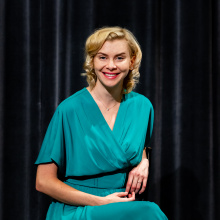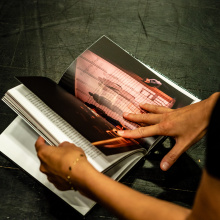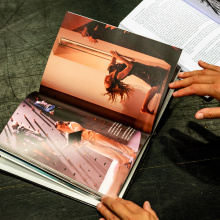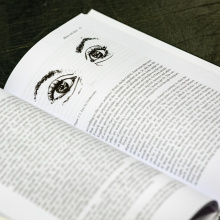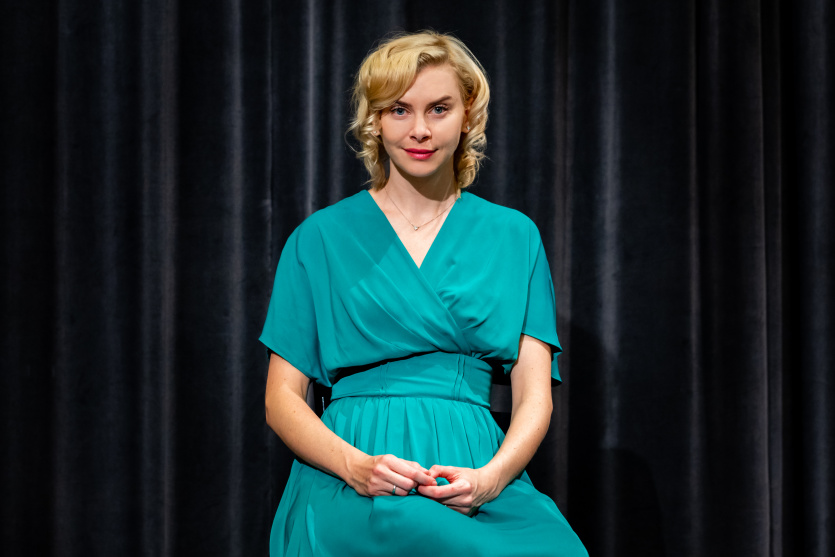
Dr Sylwia Dobkowska: 'I am fascinated by the fact that theatre is different in different places around the world. That's why, during my PhD at the Royal Holloway University of London, I focused on presenting the phenomenon of absence in theatre. This is extremely difficult because absence is about what doesn't exist. For that, it is everywhere and it is very important because everyone perceives what is absent in their own way.' Photo by Alan Stocki UG
She lived in Japan for six years and now works at the Department of Performing Arts Research of the Institute of English and American Studies at the Faculty of Philology of the UG and researches kumiodori, traditional musical theatre from Okinawa. I talk to dr Sylwia Dobkowska about her latest research, which brings together issues related to world theatre and the English language.
Elżbieta Michalak-Witkowska: - You are currently conducting several projects simultaneously. Will you introduce them briefly?
Dr Sylwia Dobkowska: - Yes. My monograph Performance of Absence, describing the role of absence in the performing and visual arts around the world, has just been published. Another project is my work on Okinawan theatre, called kumiodori, this is a theatre from the tropical Riukiu Islands, not yet known in Poland. I am also researching creativity in learning another language (I include my students in this research), and my most recent interest is the topic of the climate crisis, particularly in the marine environment, and the role of performing arts in communicating narratives about this problem.
- Where did your love for theatre come from?
- My foray into the subject began at the age of 6, in a pre-school group class. I knew straight away that this was not a passing fondness. For me, theatre is the perfect place to think about things, reflect on events, to compare what used to be with what is happening now. I find it very important, and at the same time fascinating, that reality and theatre constantly intermingle.
- Your role as an actress was only the beginning of your theatrical adventure. Along the way, you also got a taste of directing, stage design and production design.
- I was still acting on stage in high school. I decided then that I was going to go into acting. So I got into drama school in the UK. The teaching system there is a bit differently organised than in Poland - you learn acting on stage, you learn elements of directing and set design, different aspects of being in theatre, and only later, when you get to know the role of different members of the community, you choose your path - I concluded that I needed independence. That's why I focused on set design and directing. For my MA, I got into design at Goldsmiths University in London - here I found myself designing books. I started to think about how theatre could be represented in an unusual, flat form and how to render a theatrical performance page by page. In a book called Justitia: Multidisciplinary Readings of the Work of the Jasmin Vardimon Company, I showed that it could. We were able to record the experience of a performance entitled Justitia, a multi-layered, multi-media dance theatre performed by the Jasmin Vardimon Company.
- You tell the story with great passion. I get the impression that you are also captured by the diversity in theatre?
- I'm definitely fascinated by the fact that theatre is different in different places around the world. That's why, during my PhD at the Royal Holloway University of London, I focused on presenting the phenomenon of absence in theatre. This is extremely difficult because absence is about what doesn't exist. For that, it is everywhere and it is very important because everyone perceives what is absent in their own way. In the theatre and our everyday lives, we live with memories and expectations that are not physically present but are important to us. In my monograph, Performance of Absence, I note the positive role of intentionally leaving empty space as a place for others, a place for the future or growth...
- Since there is no single model of absence, how do we study this phenomenon?
- Absence in theatre is a cultural phenomenon. I think it's interesting to collect different models of absence and compare them with each other, to see what the relationship between spectator and artist looks like in different stage plays (not only in theatre but also in art installations or performances). Then it is also worth seeing how we see the relationship between each other in society through the prism of theatre.
There are a lot of abstract performances in Polish theatre, not fully connected to each other, and it is this non-connection that is the place where the spectator can make his interpretation. Let me perhaps use an example. When there is an issue in public life, we often choose only one interpretation. And yet there could be more. We need more than one interpretation, and for that we need openness. We need to plan and leave room in this for others, giving them the chance to join in the dialogue. This is the empty space that could be adopted in society.
My adventure with absence started with British theatre, then I became interested in Japanese theatre and there I saw that things were very different, that theatre was interpreted differently, especially in Japan, where an element like 'ma' (間), or empty space, is a compositional element.
- You lived in Japan, Okinawa to be precise, for six years. Is that why you are devoting yourself academically to the study of kumiodori theatre, little known in Poland?
- There are different types of theatre forms in Japan. Around the 13th century nō theatre (traditional theatre, mainly for the aristocracy, unchanged to this day) and kyōgen farce developed, in the 17th-century kabuki theatre, bunraku or puppet theatre (also known as ningyō jōruri) was created. We also have kagura, gagaku or kumiodori theatre and many other original contemporary forms. Kumiodori, by virtue of where I used to live, was closest to me. I could simply attend these performances frequently. And since there was no article describing it in Poland, I thought I would create one myself: 'Kumiodori - theatre of the kingdom of Riukiu'.
Kumiodori theatre is very interesting. Imagine that it was created to order in 1719. It was created by one man, Tamagusuku Chōkun, based on the various theatres available to him, namely Japanese kabuki, Chinese opera and Riukiuan ritual songs. It is a very sing-songy and colourful theatre in which the actors are constantly in motion. The movement and sound are modelled by the ocean tide and never die down, not even for a millisecond.
There are quite a few interesting facts about kumiodori. It was played mainly by samurai (the aristocracy of Riukiu), who even wrote poetry. It is a theatre where one admires the artistry and the way an actor plays a role - for everyone knows the content of the play, as it has been performed for centuries.
- It is a little different with us. After all, we often don't know what the play is going to be about. We can, of course, check the description in the repertoire or read a review if one is already available.
- What is definitely more important in kumiodori theatre is the acting of the actors. These are people who grew up in acting families and who first watched their fathers as actors. The family was their first school. The actor learns not only acting from his father, but also the art of make-up. This one is always done by the actor, both before the first and subsequent scenes.
For example, in a theatre with puppets (bunraku), by the way very large - they are up to 1.5 metres high - three people are involved. The oldest in age and experience, the so-called Master, operates the head and the right hand. The second person takes care of the left hand, and the youngest person always operates the legs (it is an uncomfortable position). To become a master and operate the head, the puppeteer works for as much as 30 years and during this time he perfects his precision to do it as well as possible. It is fascinating how much dedication and perseverance it takes to work on stage.
- Your most recent interest is the topic of the climate crisis and the role of performing arts in communicating narratives around this issue. You are particularly interested in narratives related to the sea, right?
- Exactly. Right now, I will be exploring the connection between theatre and the sea, and the topic of the climate crisis. A lot is going on in Japan on this issue. It's a country that lives practically from the sea and from the ocean. This aspect is important in culture, society and even politics. In Japan, there are so-called sea people (uminchu) or pearl fishers (ama) famous for diving without cylinders or other equipment and fishing various things out of the water. There are also various underwater installations taking place, which I hope to see. I think it is important to show the relationship between man and the sea and to emphasise that the sea is not only what is on the surface. It 'happens' inside as well. I'm a scuba diver and I see coral reefs disappearing, it's really stopped being so colourful underwater over the last few years. Everything is slowly fading away. I think it is necessary to bring this perspective also in the performing arts and talk more about the sea.
I have another research trip ahead of me to Japan as part of the Between.Pomiędzy research group thanks to a grant from the University of Gdańsk - I will have the opportunity to act.
- So good luck with your further research. Thank you for the interview.

